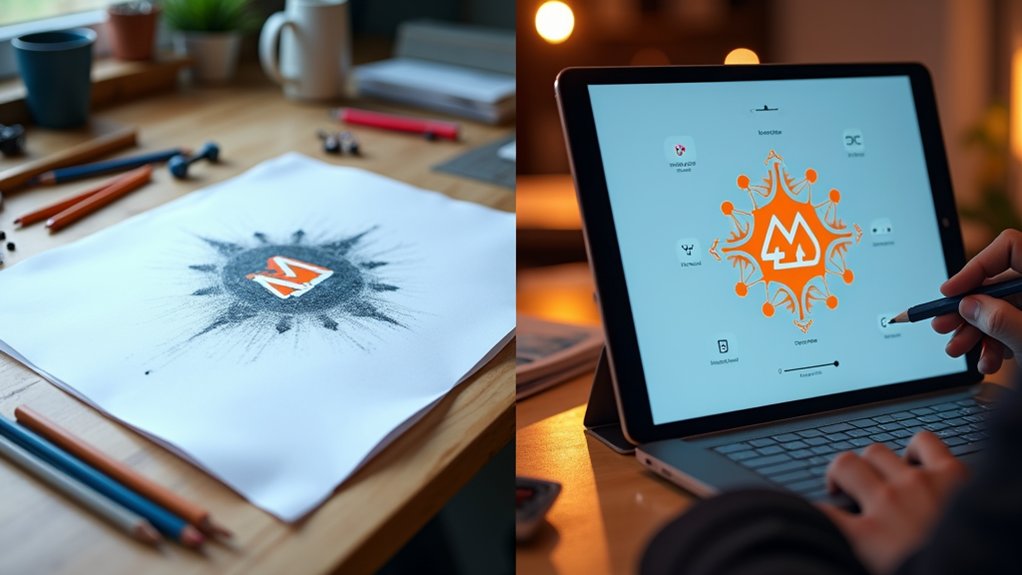Can AI Design a Better Logo?
AI can design effective logos by leveraging sophisticated algorithms that analyze brand requirements and industry standards. Modern AI platforms generate unique designs with customization options for color palettes, styles, and formats—all without requiring design experience from users. With 36.7% of small businesses now utilizing online logo builders and the market projected to reach $12.34 billion by 2028, AI-designed logos offer accessibility and affordability, though they still face limitations in creative originality and intuitive design choices that human designers excel at.

How effectively can artificial intelligence now design logos that rival human-created alternatives? The evidence suggests rapidly growing capabilities, with the AI-powered logo design market projected to reach $12.34 billion by 2028, expanding at a 14.3% compound annual growth rate. This expansion is fueled by widespread adoption, with 36.7% of small businesses already utilizing online logo builders for their branding needs. North America leads in market share at 35%, followed by Europe (27%) and Asia Pacific (23%), indicating the global significance of this technological shift.
The technical sophistication of AI logo design tools has increased substantially, now offering remarkably advanced customization capabilities. Modern platforms generate unique designs tailored to specific brand palettes, with tools like Canva’s Dream Lab enabling real-time variations and style modifications. These systems support diverse formats including 3D renders, illustrations, and color sketches, while allowing users to upload reference images for consistent style alignment. Like more advanced AI art generators, these tools can transform abstract brand concepts into cohesive visual identities.
The resulting high-fidelity outputs are professional-quality and suitable for both digital and print applications. User accessibility represents a significant advantage, as these tools require no design experience while delivering impressive results. Step-by-step interfaces guide users through creation processes, with multiplatform compatibility enabling exports in both scalable vector formats (SVG, EPS) and raster formats (PNG, JPG). The growing popularity of platforms like Zoviz at just $19.99 one-time makes professional branding accessible to entrepreneurs with limited budgets.
This accessibility is particularly valuable considering that 75% of consumers identify brands primarily by their logos, with 90% of brand recognition stemming from logo-driven first impressions. The strategic implementation of descriptive AI prompts that focus on color, style, and overall aesthetic elements can significantly enhance the quality of AI-generated logo designs.
Despite these advancements, AI logo design faces notable challenges. Creative limitations exist due to algorithmic patterns potentially lacking originality, while success depends heavily on precise prompt phrasing and keyword selection. The absence of human intuition means AI struggles to replicate subtle design choices made by experienced creators.
Additionally, template repetition creates the risk of similar-style outputs across widespread user bases, and output quality remains inconsistent across different prompts or style applications. While tools like Canva’s Dream Lab and Looka offer impressive capabilities, the technology continues to progress toward bridging these remaining gaps.
Frequently Asked Questions
How Much Does AI Logo Design Typically Cost?
AI logo design services typically range from free to $20 for basic generators, while premium AI-powered platforms charge $20-$50 monthly for more sophisticated options.
Many services operate on subscription models, offering tiered pricing based on design complexity, file formats, and usage rights.
Enterprise-level AI logo design solutions may cost $100+ per month, providing businesses with advanced customization features, unlimited revisions, and extensive brand identity packages.
Can I Customize Ai-Generated Logos After Creation?
Most AI logo design platforms offer extensive post-generation customization options. Users can typically modify fonts, colors, layouts, and individual design elements through intuitive editing interfaces.
Advanced systems provide layered editing capabilities, allowing separate manipulation of text, icons, and backgrounds. Many platforms also include brand kit amalgamation, multi-format exports (PNG, SVG, EPS), and visualization tools to preview logos on various materials.
These customization features enable users to refine AI-generated designs to align precisely with their brand identity requirements.
Do AI Logos Come With Commercial Usage Rights?
AI-generated logos typically do not automatically include commercial usage rights. Rights vary considerably by platform and subscription tier.
Premium packages often grant full commercial rights, while free versions typically restrict usage to personal projects. Users must carefully review each platform’s terms of service, maintain documentation of acquired rights, and may need to purchase specific licensing to legally use AI logos for business purposes.
Human refinement of AI designs is recommended for enhanced trademark eligibility.
How Long Does AI Take to Generate Logo Options?
AI logo generation typically occurs in under 60 seconds, with most platforms producing multiple design options in 15-45 seconds.
The speed varies based on several factors including server load, complexity of design parameters, and the specific AI technology utilized.
Modern systems like DALL-E 2 and Midjourney can process thousands of requests simultaneously, enabling rapid generation without compromising quality.
Enterprise-level solutions may offer even faster processing times for high-volume clients requiring immediate visual assets.
Are Ai-Designed Logos Unique Enough to Trademark?
AI-generated logos face significant trademark challenges due to their lack of human authorship and originality.
Current legal frameworks require human creativity for copyright protection, while trademark eligibility demands unique design elements. Most AI logos merely “remix” existing designs from training data, failing to meet legal uniqueness thresholds.
Businesses seeking trademark protection should implement human modifications to AI-generated designs, maintain thorough documentation of the creation process, and conduct extensive trademark searches to mitigate potential infringement risks.